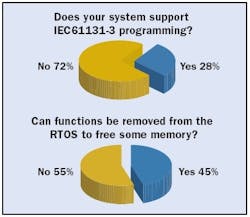Show us your RTOS
SUMMER SEEMED like a good time to take an informal poll of our machine-control readers to get a handle on the types of PC-based operating systemswith or without a third-party RTOSthat these professionals are using, the types of performances theyre getting, and their evaluation of how these meet current needs.
We distilled the responses and thoughts of nearly 100 of our readers down to a few meaningful observations. Dont view the numbers as statistically defendableits not a big enough samplinginstead, we present them as an indication of whats going on. Its also an opportunity for you to react to the numbers and tell us what you think about them.
|
Join Machine Builder Nation and tell us your operating system story at www.ControlDesign.com/RTOS.html or e-mail [email protected].
|
Windows XP as a standalone OS was most frequently identified, and named by 30% of respondents. NT/2000 as a standalone was named 13% of the time, as was Windows 98. Windows with a third-party RTOS was named by 15%. Surprisingly, Windows CE wasnt named at all. We have plenty of anecdotal evidence that supports this next result: a 22% other response, which was made up primarily of DOS and systems identified as proprietary. Clearly, there still are a lot of legacy controls out there taking care of business. Linux was named by 2% of the respondents.
Remembering that only 15 respondents reported using a third-party RTOS/kernel with a Windows OS, four people mentioned WindRiver VxWorks, while QNX was named by two respondents, and TenAsys, Green Hills, Embedded Java and LynuxWorks were identified by name one time each.
Not much to glean from that; so we asked the respondents about the cycle-time requirements of their control systems. Between 101 and 500 milliseconds was the answer given by more than 30% of the respondents, and their average jitter varied equally from less than 100 µsec to the most reported at between 0 and 100 msec. Nearly 25% clocked their cycle time at 0-100 msec, with similar jitter specs. About 20% said their cycle times were in the 500-999 µsec range, while their jitters were nominally around 100 µsec.
The big majority of the respondents in all speed classes said theyre largely satisfied with their stated performance. Most in the 100-500 msec range rated it good enough for now. One respondent using NT/QNX in a machining center control scheme lamented the overhead burden of the system; another using XP/VxWorks was in R&D actively looking for better performance.
Not surprisingly, almost everyone in the faster ranges rated performance as very good. One of the respondents, a rolling mill software engineer in the less-than-500-µsec range, claiming jitter below 100 µsec, says hes using DOS, hardware interrupts and absolutely doesnt need RTOS baggage to be simple, efficient, and quick.



